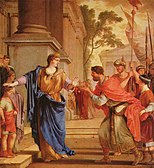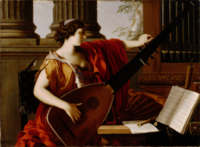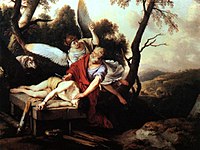Laurent de La Hyre
You can help expand this article with text translated from the corresponding article in French. (April 2022) Click [show] for important translation instructions.
|
Laurent de La Hyre | |
|---|---|
| Born | 27 February 1606 Kingdom of France (now France) |
| Died | 28 December 1656 (aged 50) Paris |
| Nationality | French |
| Known for | Painting |
| Movement | Classicism Baroque |
Laurent de La Hyre (French pronunciation: [loʁɑ̃ də la iʁ]; 27 February 1606 – 28 December 1656) was a French Baroque painter, born in Paris. He was a leading exponent of the neoclassical style of Parisian Atticism.
Life

La Hyre was greatly influenced by the work of Italian artists who came to Paris. He became a pupil of Georges Lallemand and studied the works of Primaticcio at Fontainebleau, but never visited Italy. La Hyre's captivating use of color and delicately posed figures are a trademark of his early, painteresque style. He was an innovative artist who used his superior skills as a storyteller to portray rarely depicted subjects. La Hyre is associated with the transitional period before the introduction of the French Baroque by Simon Vouet.[1]
His picture of

His drawings, of which the
In 1648, La Hyre was one of the founders of the
Richelieu called La Hyre to the Palais Royal; Pierre Séguier, Gédéon Tallemant des Réaux and many others entrusted him with important works of decoration; for the Gobelins he designed a series of large compositions. La Hyre painted also a great number of portraits, and in 1654 united in one work for the town-hall of Paris those of the principal dignitaries of the municipality.[1] His students included François Chauveau.
Works by Laurent de La Hyre
- Mythological and other themes
-
Theseus and Aethra
-
The Rape of Europa
-
Regency of Anne of Austria
-
Cyrus Announcing to Araspas that Panthea Has Obtained His Pardon
-
CorneliaRefuses The Crown of The Ptolomai (1646)
-
Hercules and Omphale (1626)
- Seven Liberal Arts
-
Allegory of Astronomy (1649)
-
Allegory of Geometry (1649)
-
Allegory of Music (1649)
-
Allegory of Arithmetic (1650)
-
Allegory of Dialectic (1650)
-
Allegory of Grammar (1650)
-
Allegory of Rhetoric (1650)
- Biblical themes
-
Christ in Emmaus
-
Abraham Sacrificing Isaac
-
Laban Searching Jacob's Baggage for the Stolen Idols
-
Jesus Appearing to the Three Marys
References
- ^ a b c Encyclopædia Britannica, 1911
- ^ Mémoires pour servir à l'histoire de l'Académie royale de Peinture et de Sculpture depuis 1648 jusqu'en 1664, Ed. Anatole de Montaiglon, Paris 1853, vol. I, p. 36.
Sources
- This article incorporates text from a publication now in the public domain: Chisholm, Hugh, ed. (1911). "Lahire, Laurent de". Encyclopædia Britannica. Vol. 16 (11th ed.). Cambridge University Press. p. 80.
Birmingham Museum of Art (2010). Birmingham Museum of Art Guide to the Catalog. London: Giles. 9781904832775.
External links
 Media related to Laurent de La Hyre at Wikimedia Commons
Media related to Laurent de La Hyre at Wikimedia Commons- Orazio and Artemisia Gentileschi, a fully digitized exhibition catalog from The Metropolitan Museum of Art Libraries, which contains material on Laurent de La Hyre (see index)
- A Caravaggio Rediscovered, The Lute Player, an exhibition catalog from The Metropolitan Museum of Art (fully available online as PDF), which contains material on La Hyre (see cat. no. 19)

















